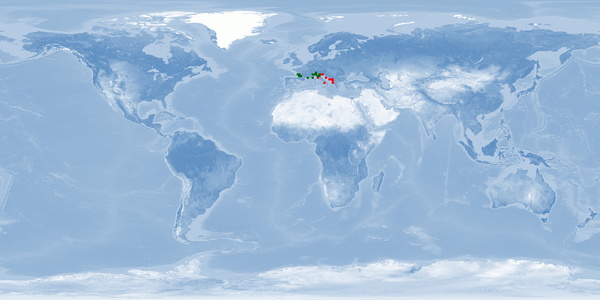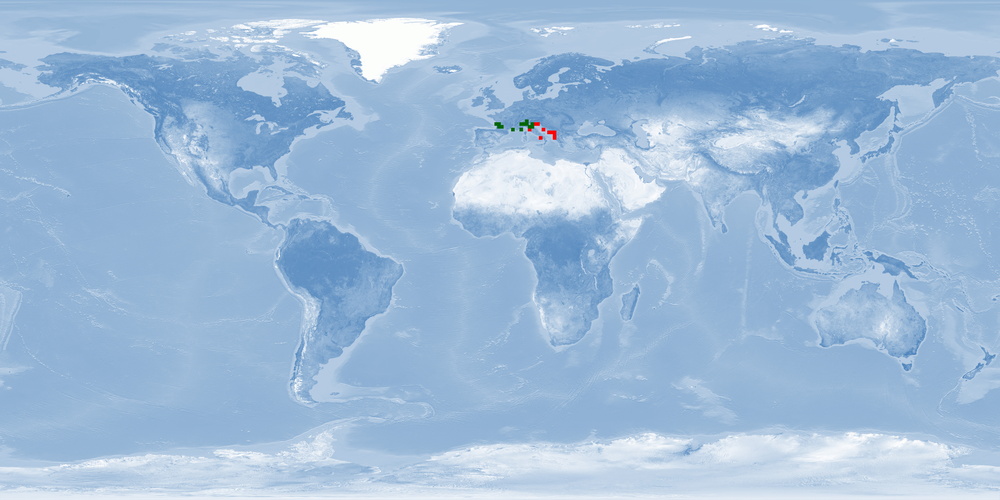Information
Version: B | 1.3 (2022-07-20)
WelfareScore | farm
Condensed assessment of the species' likelihood and potential for good fish welfare in aquaculture, based on ethological findings for 10 crucial criteria.
- Li = Likelihood that the individuals of the species experience good welfare under minimal farming conditions
- Po = Potential of the individuals of the species to experience good welfare under high-standard farming conditions
- Ce = Certainty of our findings in Likelihood and Potential
WelfareScore = Sum of criteria scoring "High" (max. 10)
General remarks
Acipenser naccarii is a critically endangered species of the sturgeon family. It was probably driven to extinction in the wild due to overfishing and was preserved solely due to the efforts of regional governments and fish farms (one in Italy and the other in Spain) that started a reproduction programme. Nowadays its production efforts are divided between repopulation and caviar. A minor percentage is hybridised with Acipenser baerii for meat production. It is however surprising that almost no information on the biology of this species is available and therefore neither a clear assessment of its current welfare state nor potential for improvement is possible. Further research should be dedicated to all the criteria evaluated on the list below as well as the success of the repopulation effort.
1 Home range
Many species traverse in a limited horizontal space (even if just for a certain period of time per year); the home range may be described as a species' understanding of its environment (i.e., its cognitive map) for the most important resources it needs access to.
What is the probability of providing the species' whole home range in captivity?
It is unclear for minimal and high-standard farming conditions. Our conclusion is based on a low amount of evidence.


2 Depth range
Given the availability of resources (food, shelter) or the need to avoid predators, species spend their time within a certain depth range.
What is the probability of providing the species' whole depth range in captivity?
It is low for minimal and high-standard farming conditions. Our conclusion is based on a low amount of evidence.


3 Migration
Some species undergo seasonal changes of environments for different purposes (feeding, spawning, etc.), and to move there, they migrate for more or less extensive distances.
What is the probability of providing farming conditions that are compatible with the migrating or habitat-changing behaviour of the species?
It is low for minimal and high-standard farming conditions. Our conclusion is based on a medium amount of evidence.


4 Reproduction
A species reproduces at a certain age, season, and sex ratio and possibly involving courtship rituals.
What is the probability of the species reproducing naturally in captivity without manipulation of theses circumstances?
It is low for minimal farming conditions. It is medium for high-standard farming conditions. Our conclusion is based on a low amount of evidence.


5 Aggregation
Species differ in the way they co-exist with conspecifics or other species from being solitary to aggregating unstructured, casually roaming in shoals or closely coordinating in schools of varying densities.
What is the probability of providing farming conditions that are compatible with the aggregation behaviour of the species?
It is unclear for minimal and high-standard farming conditions. Our conclusion is based on a low amount of evidence.


6 Aggression
There is a range of adverse reactions in species, spanning from being relatively indifferent towards others to defending valuable resources (e.g., food, territory, mates) to actively attacking opponents.
What is the probability of the species being non-aggressive and non-territorial in captivity?
It is unclear for minimal farming conditions. It is medium for high-standard farming conditions. Our conclusion is based on a low amount of evidence.


7 Substrate
Depending on where in the water column the species lives, it differs in interacting with or relying on various substrates for feeding or covering purposes (e.g., plants, rocks and stones, sand and mud, turbidity).
What is the probability of providing the species' substrate and shelter needs in captivity?
It is unclear for minimal farming conditions. It is medium for high-standard farming conditions. Our conclusion is based on a low amount of evidence.


8 Stress
Farming involves subjecting the species to diverse procedures (e.g., handling, air exposure, short-term confinement, short-term crowding, transport), sudden parameter changes or repeated disturbances (e.g., husbandry, size-grading).
What is the probability of the species not being stressed?
It is unclear for minimal farming conditions. It is medium for high-standard farming conditions. Our conclusion is based on a low amount of evidence.


9 Malformations
Deformities that – in contrast to diseases – are commonly irreversible may indicate sub-optimal rearing conditions (e.g., mechanical stress during hatching and rearing, environmental factors unless mentioned in crit. 3, aquatic pollutants, nutritional deficiencies) or a general incompatibility of the species with being farmed.
What is the probability of the species being malformed rarely?
It is unclear for minimal and high-standard farming conditions. Our conclusion is based on a low amount of evidence.


10 Slaughter
The cornerstone for a humane treatment is that slaughter a) immediately follows stunning (i.e., while the individual is unconscious), b) happens according to a clear and reproducible set of instructions verified under farming conditions, and c) avoids pain, suffering, and distress.
What is the probability of the species being slaughtered according to a humane slaughter protocol?
It is low for minimal farming conditions. It is high for high-standard farming conditions. Our conclusion is based on a low amount of evidence.


Side note: Domestication
Teletchea and Fontaine introduced 5 domestication levels illustrating how far species are from having their life cycle closed in captivity without wild input, how long they have been reared in captivity, and whether breeding programmes are in place.
What is the species’ domestication level?
DOMESTICATION LEVEL 4 20, level 5 being fully domesticated.
Side note: Forage fish in the feed
450-1,000 milliard wild-caught fishes end up being processed into fish meal and fish oil each year which contributes to overfishing and represents enormous suffering. There is a broad range of feeding types within species reared in captivity.
To what degree may fish meal and fish oil based on forage fish be replaced by non-forage fishery components (e.g., poultry blood meal) or sustainable sources (e.g., soybean cake)?
All age classes: WILD: carnivorous 4. FARM: no replacement of fish meal and fish oil reported in literature.
Glossary
ANADROMOUS = migrating from the sea into fresh water to spawn
DOMESTICATION LEVEL 4 = entire life cycle closed in captivity without wild inputs 20
FARM = setting in farming environment or under conditions simulating farming environment in terms of size of facility or number of individuals
JUVENILES = fully developed but immature individuals, for details ➝ Findings 10.1 Ontogenetic development
LAB = setting in laboratory environment
LARVAE = hatching to mouth opening, for details ➝ Findings 10.1 Ontogenetic development
SPAWNERS = adults during the spawning season; in farms: adults that are kept as broodstock
WILD = setting in the wild
Bibliography
2 Saraiva, João L. 2018. Personal communication.
3 Williot, Patrick, Laurent Sabeau, Joern Gessner, Giovanni Arlati, Paolo Bronzi, Tamas Gulyas, and Paolo Berni. 2001. Sturgeon farming in Western Europe: recent developments and perspectives. Aquat. Living Resour.: 9.
4 Bronzi, Paolo, Paul Vecsei, and Giovanni Arlati. 2005. Threatened fishes of the world: Acipenser naccarii Bonaparte, 1836 (Acipenseridae). Environmental Biology of Fishes 72: 66–66. https://doi.org/10.1007/s10641-004-1036-4.
5 NOAA. 2015. Adriatic Sturgeon (Acipenser naccarii) :: NOAA Fisheries.
6 Rochard, Eric, G. Castelnaud, and Mario Lepage. 1990. Sturgeons (Pisces: Acipenseridae); threats and prospects. Journal of Fish Biology 37: 123–132. https://doi.org/10.1111/j.1095-8649.1990.tb05028.x.
7 Arlati, G., A. Grassi, and A. Granata. 1999. Restocking Acipenser Naccarii in the Lombardy Region. Journal of Applied Ichthyology 15: 298–298. https://doi.org/10.1111/j.1439-0426.1999.tb00288.x.
8 Cataldi, E, P Di Marco, A Mandich, and S Cataudella. 1998. Serum parameters of Adriatic sturgeon Acipenser naccarii (Pisces: Acipenseriformes): effects of temperature and stress. Comparative Biochemistry and Physiology Part A: Molecular & Integrative Physiology 121: 351–354. https://doi.org/10.1016/S1095-6433(98)10134-4.
9 Rossi, R, G Grandi, R Trisolini, P Franzoi, A Carrieri, BS Dezfuli, and E Vecchietti. 1991. Osservazioni sulla biologia e la pesca dello storione cobice Acipenser naccarii Bonaparte nella parte terminale del fiume Po. Atti della Società italiana di scienze naturali e del museo civico di storia naturale di Milano 132: 121–142.
10 Doroshov, Sergei I. 1985. Biology and Culture of Sturgeon Acipenseriformes. In Recent Advances in Aquaculture, ed. James F. Muir and Ronald J. Roberts, 251–274. Boston, MA: Springer US.
11 Boglione, C., P. Bronzi, E. Cataldi, S. Serra, F. Gagliardi, and S. Cataudella. 1999. Aspects of early development in the Adriatic sturgeon Acipenser naccarii. Journal of Applied Ichthyology 15: 207–213. https://doi.org/10.1111/j.1439-0426.1999.tb00236.x.
12 Anonymous farmers. 2018. Personal communication.
13 Hatin, D., R. Fortin, and F. Caron. 2002. Movements and aggregation areas of adult Atlantic sturgeon (Acipenser oxyrinchus) in the St Lawrence River estuary, Quebec, Canada. Journal of Applied Ichthyology 18: 586–594. https://doi.org/10.1046/j.1439-0426.2002.00395.x.
14 Allen, P. J., C. C. Barth, S. J. Peake, M. V. Abrahams, and W. G. Anderson. 2009. Cohesive social behaviour shortens the stress response: the effects of conspecifics on the stress response in lake sturgeon Acipenser fulvescens. Journal of Fish Biology 74: 90–104. https://doi.org/10.1111/j.1095-8649.2008.02112.x.
15 Khodorevskaya, R. P., G. I. Ruban, and D. S. Pavlov. 2009. Behaviour, migrations, distribution and stocks of sturgeons in the Volga-Caspian basin. World Sturgeon Conservation Society: Special Publication 3. Norder- stedt, Germany: Books on Demand GmbH.
16 FAO. 2017. FAO Fisheries & Aquaculture - Species Fact Sheets - Acipenser naccarii (Bonaparte, 1836). World Wide Web electronic publication. www.fao.org.
17 Kynard, B., R. Suciu, and M. Horgan. 2002. Migration and habitats of diadromous Danube River sturgeons in Romania: 1998–2000. Journal of Applied Ichthyology 18: 529–535. https://doi.org/10.1046/j.1439-0426.2002.00404.x.
18 Guerrero, A, Ac Durán, Jm Icardo, B Fernández, A Domezain, and V Sans-Coma. 2007. Dorsoventral transposition of the heart chambers in sturgeon Acipenser naccarii alevins. Diseases of Aquatic Organisms 78: 173–177. https://doi.org/10.3354/dao01856.
19 Williot, Patrick, Mikhail Chebanov, and Guy Nonnotte. 2018. Welfare in the Cultured Siberian Sturgeon, Acipenser baerii Brandt: State of the Art. In The Siberian Sturgeon (Acipenser baerii, Brandt, 1869) Volume 2 - Farming, 403–450. Springer, Cham. https://doi.org/10.1007/978-3-319-61676-6_19.
20 Teletchea, Fabrice, and Pascal Fontaine. 2012. Levels of domestication in fish: implications for the sustainable future of aquaculture. Fish and Fisheries 15: 181–195. https://doi.org/10.1111/faf.12006.











